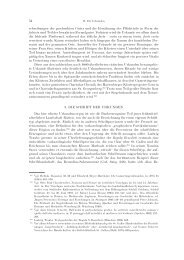Chapter Three ANTHOLOGIES AND ANTHOLOGISTS Between c ...
Chapter Three ANTHOLOGIES AND ANTHOLOGISTS Between c ...
Chapter Three ANTHOLOGIES AND ANTHOLOGISTS Between c ...
Create successful ePaper yourself
Turn your PDF publications into a flip-book with our unique Google optimized e-Paper software.
108<br />
Part One: Texts and Contexts<br />
together by Cephalas, it would mean that he had copied the epigram twice:<br />
first immediately after AP V, 83–84 and then again at AP XV, 35. Duplications<br />
of this kind are fairly normal in the anthology of Cephalas, but in<br />
practically all the instances of duplication the most likely explanation is that<br />
Cephalas found the epigram in two different copies 77 . It is unlikely, however,<br />
that Cephalas found Theophanes’ epigram in two different copies of the Sylloge<br />
Rufiniana. For when an epigram is repeated, it is usually found in its original<br />
context: a Meleagrian author among other epigrams deriving from the Garland<br />
of Meleager, etc. However, in AP XV, 28–40 Theophanes’ epigram is “out of<br />
context”: it is no longer part of the Sylloge Rufiniana where it originally could<br />
be found, but figures among contemporary epigrams. So, if AP XV, 35 is not<br />
an ordinary instance of duplication, why did Cephalas copy it twice? And why<br />
did he copy it the first time with the correct reading ½is5n and then change it<br />
to cers5n? 78 Regrettably, I cannot offer decisive proof, but I strongly suspect<br />
that AP XV, 28–40 was compiled by someone other than Cephalas.<br />
Due to a binding error the order of the epigrams in the sylloge has been<br />
reversed 79 . The original order is as follows: no. 40 and then nos. 28 to 39. The<br />
sylloge appears to have a thematic structure. It starts with two poems in<br />
pseudo-Homeric style by Kometas and Anastasios Quaestor (AP XV, 40 and<br />
28). Then we have a number of epitaphs: AP XV, 29–31 by Ignatios the<br />
Deacon and AP XV, 32–34 by Arethas. This in its turn is followed by Theophanes’<br />
erotic epigram (AP XV, 35). The sylloge ends with six book epigrams:<br />
on an edition of Homer by Kometas (AP XV, 36–38), on a Homeric grammar<br />
by Ignatios the Deacon (AP XV, 39, v. 1 and vv. 2–3), and on Plato by an<br />
anonymous author (AP XV, 39, vv. 4–5).<br />
The author of AP XV, 40, Kometas, is not entirely unknown to us. He was<br />
appointed professor of grammar at the Magnaura school in the 840s and<br />
produced a punctuated edition of the two Homeric epics 80 . In AP XV, 36–38,<br />
epigrams that served as an introduction to this edition, Kometas emphasizes<br />
the magnitude of the problems he faced when he transliterated Homer from<br />
77 See CAMERON 1993: 43–48.<br />
78 See CAMERON 1993: 284.<br />
79 After the binding error had been made, scribe J rewrote in the top margin of p. 693 the<br />
first nine lines of AP XV, 28, which had become acephalous. In the lemma he added the<br />
nickname of Anastasios Quaestor: Ö Traylöß, and in v. 2 he supplemented a lacuna: Çczn.<br />
There is no need to suppose that he used another manuscript to come up with these two<br />
insignificant additions.<br />
80 Theoph. Cont. 192, 19–20. On Kometas and his scholarly work on Homer, see LEMERLE<br />
1971: 166–167, R. BROWNING, Viator 6 (1975) 22–23 (repr. in: idem, Studies on Byzantine<br />
History, Literature and Education. London 1977, no. 17), ALPERS 1991: 254–257, and G.<br />
CORTASSA, Prometheus 23 (1997) 222–228.




